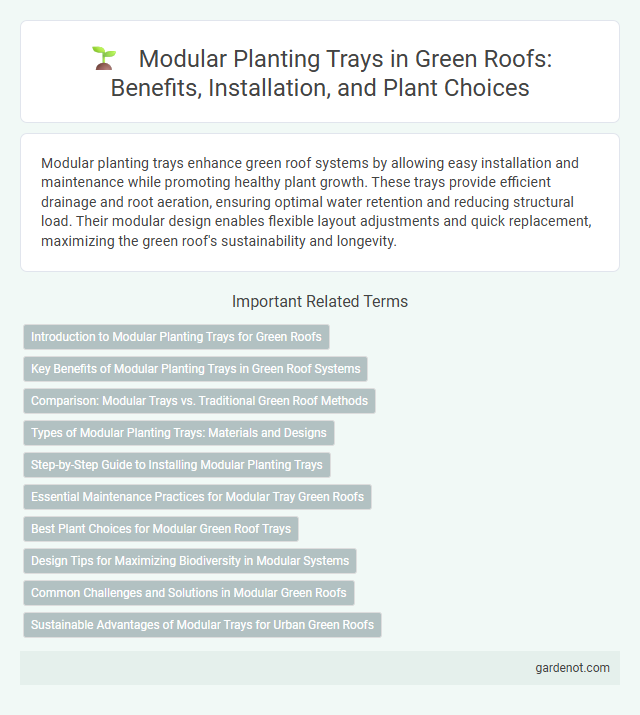Modular planting trays enhance green roof systems by allowing easy installation and maintenance while promoting healthy plant growth. These trays provide efficient drainage and root aeration, ensuring optimal water retention and reducing structural load. Their modular design enables flexible layout adjustments and quick replacement, maximizing the green roof's sustainability and longevity.
Introduction to Modular Planting Trays for Green Roofs
Modular planting trays for green roofs offer a flexible and efficient solution for vegetation installation and maintenance, enabling quick setup by pre-growing plants in controlled environments. These trays typically consist of lightweight, durable materials designed to support diverse plant species while facilitating optimal water drainage and root aeration. Their standardized sizes simplify transportation and replacement, promoting sustainable urban greening and enhancing the overall performance and lifespan of green roof systems.
Key Benefits of Modular Planting Trays in Green Roof Systems
Modular planting trays enhance green roof systems by streamlining installation and maintenance through pre-grown vegetation modules, reducing labor costs and minimizing plant stress. Their customizable design improves drainage and soil retention, optimizing water management and promoting healthier plant growth. These trays also facilitate rapid vegetation establishment and increased biodiversity, contributing to improved thermal insulation and urban heat island mitigation.
Comparison: Modular Trays vs. Traditional Green Roof Methods
Modular planting trays offer improved installation speed and uniform plant establishment compared to traditional green roof methods, which often require on-site extensive layering and seeding. These trays ensure precise plant spacing and reduce soil erosion risks, enhancing overall system durability and maintenance efficiency. In contrast, traditional green roofs may face inconsistent growth patterns and longer establishment times due to their variable substrate application.
Types of Modular Planting Trays: Materials and Designs
Modular planting trays for green roofs come in various materials such as recycled plastic, polypropylene, and biodegradable composites, each offering durability and sustainability benefits. Designs range from shallow, segmented trays ideal for sedum and succulents to deeper trays that support diverse plant communities and enhanced root growth. The choice of material and design influences water retention, drainage efficiency, and ease of installation, crucial factors for green roof performance.
Step-by-Step Guide to Installing Modular Planting Trays
Begin the installation of modular planting trays by ensuring the roof surface is clean, waterproofed, and structurally sound to support additional load. Place trays systematically, aligning drainage holes and securing interlocking edges to create a uniform planting bed; fill each tray with lightweight, engineered green roof substrate optimized for water retention and root growth. Finally, install selected vegetation suited to the local climate, maintaining appropriate irrigation and monitoring moisture levels to ensure successful establishment and long-term green roof performance.
Essential Maintenance Practices for Modular Tray Green Roofs
Modular planting trays in green roof systems require regular inspection to prevent plant stress and ensure optimal growth by monitoring soil moisture levels and drainage efficiency. Routine maintenance involves removing debris, controlling weeds, and replacing damaged or dead plants to maintain both structural integrity and aesthetic appeal. Employing these essential practices extends the lifespan of modular trays while enhancing the overall performance of green roof ecosystems.
Best Plant Choices for Modular Green Roof Trays
Succulents such as Sedum species thrive in modular planting trays due to their drought tolerance and shallow root systems, making them ideal for extensive green roofs. Hardy perennials like Delosperma and Sempervivum offer vibrant color and low maintenance requirements, enhancing the ecological and aesthetic value of modular green roof setups. Selecting native grasses and wildflowers can improve biodiversity and promote local wildlife, supporting sustainable urban environments.
Design Tips for Maximizing Biodiversity in Modular Systems
Modular planting trays designed for green roofs should incorporate diverse plant species with varying root depths and growth patterns to enhance biodiversity and ecosystem resilience. Selecting a mix of native perennials, sedums, and grasses ensures habitat variety while supporting pollinators and improving soil health within modular units. Strategic spatial arrangement and regular maintenance optimize plant health and ecological function, contributing to a sustainable, biodiverse green roof system.
Common Challenges and Solutions in Modular Green Roofs
Modular planting trays in green roofs often face challenges such as inadequate water retention, root entanglement, and uneven plant growth. Solutions include using high-quality, lightweight substrates with superior water-holding capacity, designing trays with root barriers to prevent entwining, and implementing varied planting schemes to promote uniform vegetation coverage. Regular maintenance and monitoring can also mitigate issues related to drainage and plant health, ensuring long-term system performance.
Sustainable Advantages of Modular Trays for Urban Green Roofs
Modular planting trays enhance urban green roofs by promoting sustainability through efficient water retention and reduced soil erosion. These trays facilitate easy installation and maintenance, minimizing resource consumption and supporting biodiversity in densely populated areas. Their reusable design lowers waste generation and extends the lifespan of green roof systems, contributing to eco-friendly urban development.
Modular planting tray Infographic

 gardenot.com
gardenot.com